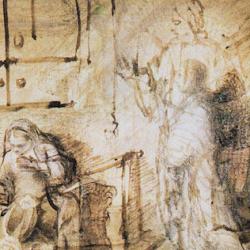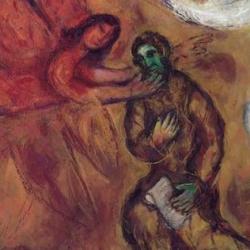Some scattered notes on Isaiah 33, the product of listening to students comment on the passage in exams throughout the week.
1) Verse 1 includes an interesting variation on the lex talionis. Destroyers will be destroyed, and the treacherous will be dealt with treacherously. But the justice that the Lord threatens is even more precise than this. The destroyer destroyed when he was not being destroyed, and the treacherous betrayed the faithful who did not betray them. Their punishment will be a precise inversion of their crime: They will be destroyed once they stop destroying others; they will be betrayed when they cease betraying. They did harm when no harm was being done them, and so harm will come on them when they are no longer doing harm. A good warning to those who think that they’ve gotten away with something.
2) The simile that compares the gathering of soil to the gathering of the caterpillar (v. 4) is odd. The locusts make more sense: Men will rush on the spoil like locusts on a crop. This draws an analogy between defeat in war and locusts, but also conjures the image of the locust plague of Egypt, a reference to Egypt that will be filled out later in the passage.
3) Verse 9 personifies the land as “mourning” and “pining,” and the remainder of the verse describes a desertification of four regions of Israel. The forests and orchards of the land are turning to desert, and the desert is fourfold, spreading to the four points of the compass.
4) Verse 11 is a powerful image. The first line uses the language of conception and birth, but the product of this birth is not seed or fruit, but refuse – chaff and stubble – the leftovers after harvest. This might be a literal reference to children who are born already destined for burning and blowing; alternatively, the birth might itself be a metaphor for planning and acting. In either case, Israel is producing only fuel for the fire.
5) Fire dominates verses 11-14. Yahweh’s breath is like fire; the peoples are burned to lime, and flare up like cut thorns; sinners wonder who can live in the presence of the burning fire and the continual burning. The desertification imagery of verse 9 has taken on a deeper apocalyptic edge, as the land not only withers but is consumed in fire. This is not only Egypt, but Sodom.
6) Yet, verses 15-16 give hope in the midst of the consuming fire. Whoever walks in righteousness and keeps from evil will find refuge. Yahweh is on high (vv. 5, 10), and the righteous will be raised up with Him (v. 16a). The righteous will find a refuge in the Lord, in a rock fortress. The combination of rock, bread, and water evokes the image of Israel in the wilderness. Here, Israel has become a wilderness, burned to ash like the land around Sodom, but in the midst of that desolation the Lord will preserve the righteous on a high rock and provide bread and water. The scene is not only the exodus, but also the various bread-and-water scenes in the central chapters of 1-2 Kings.














